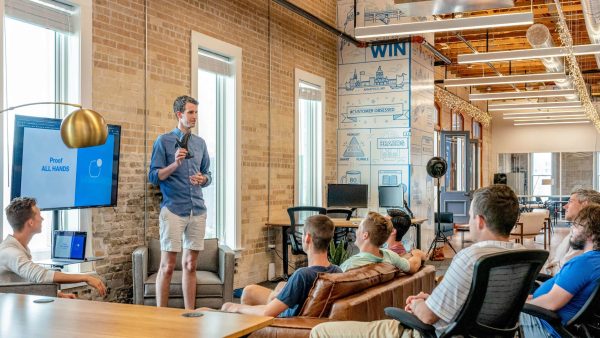Reaching learning and development goals is critical for organizational development. Choosing the right delivery method for the organization’s learning content can present more benefits than simply delivering the courses. It can include functionalities and capabilities for keeping learners engaged, helping learners to work together and making the workflow easier for learning and development teams. An LMS is an excellent example of how a comprehensive system can provide more robust opportunities than traditional development methods.
What is an LMS?
LMS stands for learning management system, which is a platform for delivering and tracking learner progress on courses. Common basic features of an LMS include Content Creation (such as Reading Material and Videos), Assessments, and Reporting.
A corporate learning management system is an LMS intended for businesses rather than educational institutions. A corporate LMS is primarily used by organizations for employee development including upskilling, and reskilling with an end goal defined by the organization’s learning and development strategy.
What are the Uses of a Corporate LMS?
Since an LMS delivers learning material, its primary functionalities can be split into two categories: user management and tracking learning progress.
- User Management
Managing users includes various processes such as adding new learners to the platform and communicating with certain teams and departments.
Examples of Qbic features for user management include:
- Custom User Attributes-
Admins can match organizational structure by deciding on custom attributes to replicate organizational structure within the system. These attributes will be used by the system to determine the criteria used by the system to assign Learning Paths.
- Workspaces-
Admins are able to manage multiple, independent entities within an account using Workspaces. These independent spaces separate the learning content, learners, and individual branding for each entity.
- Tracking Learning Progress
Tracking learning progress is a core function of a corporate LMS because it ultimately provides learning and development teams with the ability to gauge the organization’s progression towards learning and development goals.
Common examples of LMS features that track learning progress include:
- Reporting
Metrics within reporting that aide in measuring learning progress are the learner completion rates versus courses that are in-progress. A more user-friendly LMS allows for an adjustment of the scope to teams, departments, etc.
- Learning Paths
Since a learning path is a visual representation of the courses a learner must complete to fulfill training, viewing a learner’s current Learning Path and their progression through it is an excellent method for understanding how far along their training they are.
Important Aspects of Learning an LMS Should Include
Engagement:
Learner engagement is an important learning fundamental to be supported by a corporate LMS. High learner engagement with the learning content results in a higher completion and retention rate of the content. If engagement is low, it can indicate that the learning program needs to be revisited or updated.
One feature of engagement is gamification. Gamification enables learners to earn points,badges, points, and digital certificates. Keeping score through the application of game-like elements not only encourages learners but stimulates an enjoyable learning adventure.
Social Learning:
Social learning also known as “collaborative learning” is when individuals work together and learn from each other. Social learning features within an LMS promote team participation, additional support for learning material, promoting further engagement with the material. A commonly found feature that promotes social learning is Discussion Forum. Discussion Forums are a channel for learners to pose inquiries regarding specific courses and engage with each other around the topic.
Ease of Use/User Experience:
If the learners or designated admins are not able to work with the LMS smoothly, it becomes harder for the organization to start and stay engaged with the learning content. If the LMS is only easy to use for admins, then learners may not stay engaged with the learning material, defeating the purpose of having an LMS to make sure everyone is learning new skills. If the corporate LMS is not simple for every user, the organization can even give up in trying to adopt the LMS.
Examples of capabilities for ease of use include:
- For learners- Online Access
Having online capabilities because learners can access learning content from any location on their own schedule. A more user-friendly LMS will be able to provide support for remote learning. This can include features such as Qbic’s 1-on-1 Private Chat.
- For admins- Qbic’s Custom Banners and Announcements
At times admins need to send important information to the entire organization or to certain departments and teams. With a feature such as Qbic’s Custom Banners and Announcements, admins are able to deliver important information with mass updates and send tailored messages to certain groups.
The right corporate learning management system can offer organizations more than just delivering training content. With features such as discussion forums, online accessibility, and learning paths, a corporate LMS can set foundations for a better learner experience. With features such as Workspaces and 1-on-1 Private Chat, Qbic provides options for better communication and organization along with content delivery.


